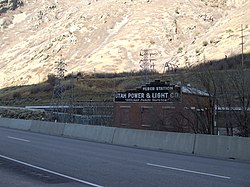Devil's Gate-Weber Hydroelectric Power Plant
|
Devil's Gate-Weber Hydroelectric Power Plant Historic District
|
|
 |
|
| Location | I-84 E of jct. with US-89, power plant in Weber County; dam in Morgan County, Utah |
|---|---|
| Coordinates | 41°08′15.3″N 111°53′05″W / 41.137583°N 111.88472°WCoordinates: 41°08′15.3″N 111°53′05″W / 41.137583°N 111.88472°W |
| Area | 3.3 acres (1.3 ha) |
| Built | 1908 |
| Architect | Multiple |
| Architectural style | Late 19th And Early 20th Century American Movements |
| MPS | Electric Power Plants of Utah MPS |
| NRHP reference # | 89000276 |
| Added to NRHP | April 20, 1989 |
The Devil's Gate-Weber Hydroelectric Power Plant was built in 1909-1910 on the Weber River of northeastern Utah, USA, about 10 miles (16 km) southeast of Ogden, Utah. It was built by the Utah Light and Railway Company under the direction of E.H. Harriman, a director of the Union Pacific Railroad. It was one of the first powerplants in Utah designed to feed an electrical grid rather than as a source of power of a single locality.
Work had begun on an intake structure in Weber Canyon in the early 1900s at the Devil's Gate location under the direction of C.K. Bannister, an engineer from Ogden. Bannister's plan for a hydroelectric station was contested by the Union Pacific, whose line ran through the canyon. Bannister died shortly after, and his business associates sold the property rights to the Utah Light and Railway Company. Work continued on a penstock to feed the power plant until Harriman acquired sixty percent of the UL&R. With Harriman's ownership Union Pacific opposition to the plant ceased, on the condition that a retaining wall be built to protect the railroad grade. The powerhouse was built in 1909-1910, along with three residences for plant operators. Harriman died in 1914 and the UL&P became the locally owned Utah Light and Traction Company, which leased the station to the Utah Power and Light Company. The dam was rebuilt in 1916-1917 to better accommodate flood flows. Another operator's residence was built in 1922, together with some utility structures in ensuing years. The plant was upgraded from 2.5 MW to 3.5MW in 1948. Automation allowed a reduction in staff in the 1960s, and two of the residences were demolished. The remaining two were damaged by flood in 1982. A fire in 1983 resulted in renovations and alterations to the powerhouse.
Water is fed to the powerplant from a low dam about 1.75 miles (2.82 km) upstream. Overflow is controlled by two tainter gates between concrete piers. A 3-foot (0.91 m) wide fish ladder climbs the north side of the dam. On the south side a large sluice gate allows the small reservoir to be drained. The intake structure is between the sluice gate and the south buttress wall, housed in a small wood frame intake house.A one-story wood-frame watchman's house is just downstream from the intake house, and is joined to the intake house. The power plant intake conduit is a 74-inch (1.9 m) diameter reinforced concrete pipe for the first 125 feet (38 m), transitioning to a welded steel pipe. This replaced 2,000 feet (610 m) of concrete pipe and 7,075 feet (2,156 m) of wood stave pipe in 1949. The conduit is buried along most of its length. It crosses the river on a 99-foot (30 m)-span riveted steel Howe truss bridge made by the American Bridge Company downstream from the dam. Total head is about 120 feet (37 m) to 140 feet (43 m). Since the conduit has been altered and is partly buried under the rail line it is not included in the historic district designation.
...
Wikipedia


